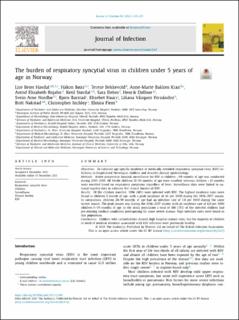| dc.contributor.author | Havdal, Lise Beier | |
| dc.contributor.author | Bøås, Håkon | |
| dc.contributor.author | Bekkevold, Terese | |
| dc.contributor.author | Kran, Anne-Marte Bakken | |
| dc.contributor.author | Rojahn, Astrid | |
| dc.contributor.author | Størdal, Ketil | |
| dc.contributor.author | Debes, Sara Molvig | |
| dc.contributor.author | Døllner, Henrik | |
| dc.contributor.author | Nordbø, Svein Arne | |
| dc.contributor.author | Barstad, Bjørn | |
| dc.contributor.author | Haarr, Elisebet | |
| dc.contributor.author | Vazquez Fernandez, Liliana | |
| dc.contributor.author | Nakstad, Britt | |
| dc.contributor.author | Inchley, Christopher | |
| dc.contributor.author | Flem, Elmira | |
| dc.date.accessioned | 2022-03-25T14:05:47Z | |
| dc.date.available | 2022-03-25T14:05:47Z | |
| dc.date.created | 2022-01-06T10:54:12Z | |
| dc.date.issued | 2021 | |
| dc.identifier.citation | Journal of Infection. 2021, 1-11. | en_US |
| dc.identifier.issn | 0163-4453 | |
| dc.identifier.uri | https://hdl.handle.net/11250/2987710 | |
| dc.description.abstract | Abstract Objectives To estimate age-specific incidence of medically attended respiratory syncytial virus (RSV) infections in hospitalised Norwegian children and describe disease epidemiology. Methods Active prospective hospital surveillance for RSV in children <59 months of age was conducted during 2015-2018. All febrile children 12-59 months of age were enrolled, whereas children <12 months were enrolled based on respiratory symptoms regardless of fever. Surveillance data were linked to national registry data to estimate the clinical burden of RSV. Results Of the children enrolled, 1096 (40%) were infected with RSV. The highest incidence rates were found in children 1 month of age, with a peak incidence of 43 per 1000 during the 2016-2017 season. In comparison, children 24-59 months of age had an infection rate of 1.4 per 1000 during the same winter season. The peak season was during the 2016-2017 winter, with an incidence rate of 6.0 per 1000 children 0-59 months of age. In the study population a total of 168 (15%) of the infected children had pre-existing medical conditions predisposing for more severe disease. High infection rates were found in this population. Conclusions Children with comorbidities showed high hospital contact rates, but the majority of children in need of medical attention associated with RSV infection were previously healthy. | en_US |
| dc.language.iso | eng | en_US |
| dc.publisher | Elsevier | en_US |
| dc.rights | Navngivelse 4.0 Internasjonal | * |
| dc.rights.uri | http://creativecommons.org/licenses/by/4.0/deed.no | * |
| dc.title | The burden of respiratory syncytial virus in children under 5 years of age in Norway | en_US |
| dc.type | Peer reviewed | en_US |
| dc.type | Journal article | en_US |
| dc.description.version | publishedVersion | en_US |
| dc.source.pagenumber | 1-11 | en_US |
| dc.source.journal | Journal of Infection | en_US |
| dc.identifier.doi | 10.1016/j.jinf.2021.12.008 | |
| dc.identifier.cristin | 1975721 | |
| dc.relation.project | Norges forskningsråd: 240207/F20 | en_US |
| dc.relation.project | Helse Sør-Øst RHF: 2016007 | en_US |
| cristin.ispublished | false | |
| cristin.fulltext | original | |
| cristin.qualitycode | 1 | |

